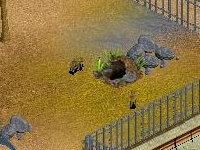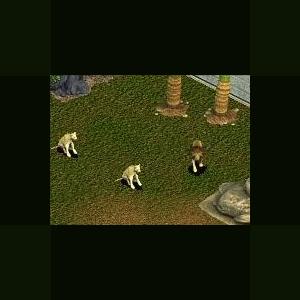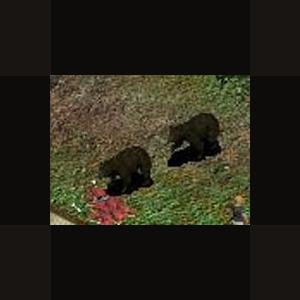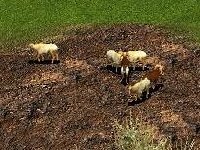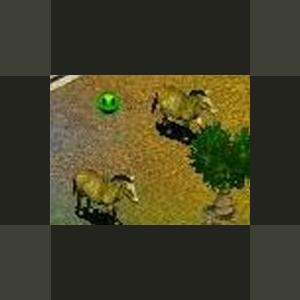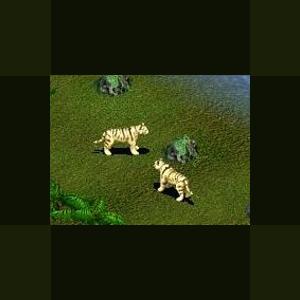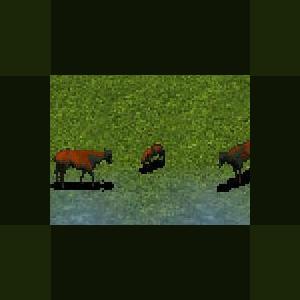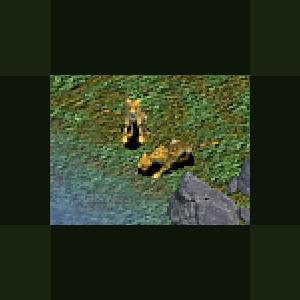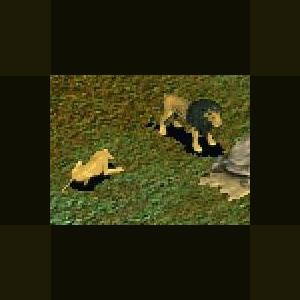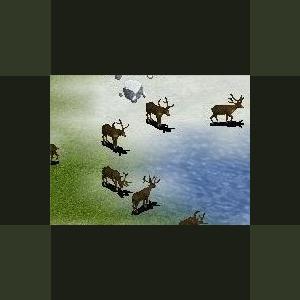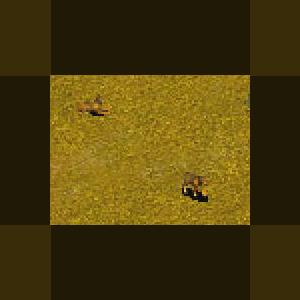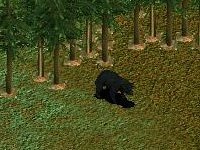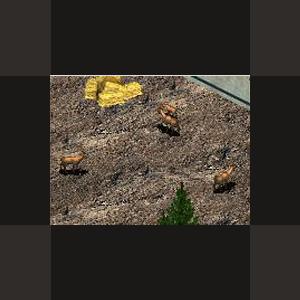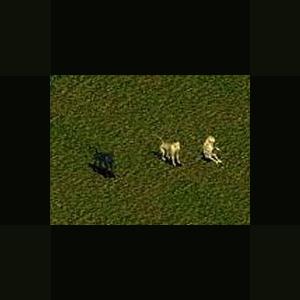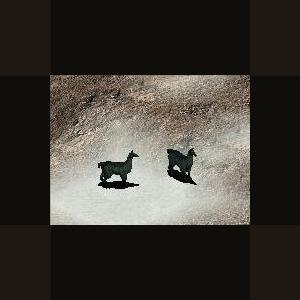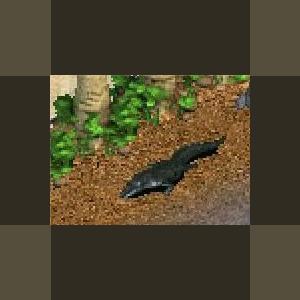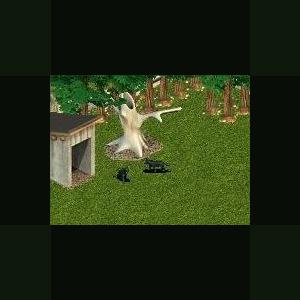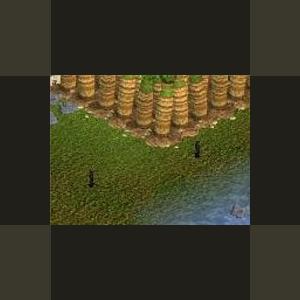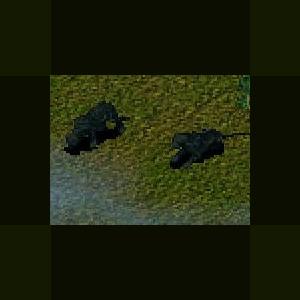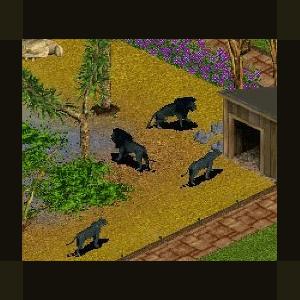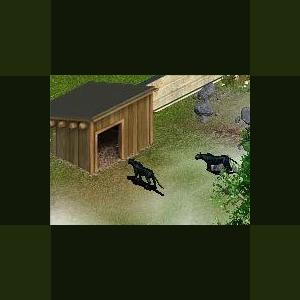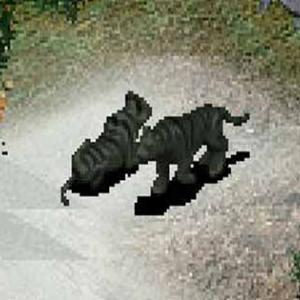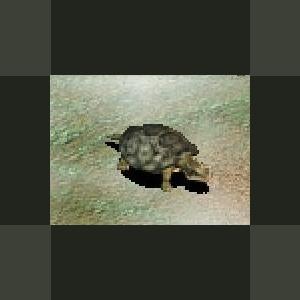279 files
-
Asian Ruppel's Fox (Sand Fox) by Ghirin
By Guest
Asian Ruppell´s Fox By Ghirin
The sand fox (Vulpes ruppelli), also known as Ruppell's fox, is native to arid and semi-arid regions in northern Africa, Arabia and central Asia, including stony desert, steppes, thornbush savannah, and dry woodland. They have a distinctive call, a "wow" sound ending in two yaps.
Sand foxes live in pairs or small family groups. They build dens, but also tend to move to a new location about once a week. Sand foxes hunt at night, preying on small mammals, insects, fruit and carrion.
Created by Ghirin 2004
Updated 2010-10-30
Just to save space with less in zip and smaller image.
Nothing new.
Updated August 18, 2018 by Cricket so that screenshot would show up again.
354 downloads
0 comments
Updated
-
Asiatic Lion by BigCatKeeper
By Guest
Asiatic Lion by BigCatKeeper
The Asiatic lion was once widespread throughout Southwest Asia. Today the species can only be found in a single location in the wild, the Gir forest in India. Although genetically distinct from the sub-Saharan African lion, the difference is not large. In fact, the difference is less than that found between different human racial groups. The closeness in genetic make-up between Asiatic and African lions indicates that the two populations separated as recently as 100,000 years ago.
The most noticeable physical characteristic found in all Asiatic lions, but rarely in African lions, is a longitudinal fold of skin running along the belly. Also, the mane of the Asiatic lion is generally shorter than that of the African lion, so the ears are always visible. Asiatic lions are, in general, slightly smaller than African lions. Studies on Gir lions yielded the following figures: adult males weighed 160-190 kg, while adult females weighed 110-120 kg. The largest Asiatic lion on record measured 2.9 m from nose to tail-tip.
Like their African cousins, Asiatic lions are highly sociable animals living in social units called prides. There are however differences in pride make up between the sub-species. Based on the average number of adult females, the Asiatic pride is smaller. Studies have shown that most Gir prides contain just two adult females as compared to the average African pride which contains 4 to 6 adult females. The largest recorded female coalition of Asiatic lionesses is a group of five. However, it must be said that despite the small population and habitat area, few individual animals are known. Further field studies may show that what are currently identified as separate prides may actually be small foraging groups from larger prides. Adult male Asiatic lions exhibit a lesser degree of sociality than African males. Asiatic males only associate with the pride when mating or on a large kill. It has been suggested that this may be due to the smaller prey species available in Gir.
The most commonly taken prey are the chital and the sambar deer. However, domestic cattle have historically been a major component of the lions’ diet. This often leads to conflict between lions and humans. Despite the strong increase shown in the wild ungulate prey base a significant proportion of lion kills still consist of livestock. It should be noted that the ease of locating livestock kills compared to wild ungulate kills may distort the true proportion of wild/domestic kills. The availability of domestic livestock has also been put forward as another cause of the loose sociality of Gir lions.
The Asiatic lioness becomes sexually mature at 3 to 4 years old. In males sexual maturity is not reached until between 5 and 8 years. Females may come into season at any time during the year and give birth to litters of between 1 and 5 cubs. The average litter is 2-3 cubs. Both males and females may continue to breed up to 15 years old.
Approximately one-third of cubs die within their first year; this mortality rate falls to less than 10% for adult lions. In the Gir, females live on average for 17-18 years, but may live to 21 years; males, on average, live up to 16 years.
The range of this lion sub-species formerly stretched from northern Greece across Southwest Asia to central India. It became extinct in eastern Europe around 100 A.D., and in Palestine around the time of the Crusades. It remained widespread elsewhere until the advent of firearms in the mid 1800s led to widespread extinction. The lion had disappeared from Turkey by the late 1800s; the last reported sightings in Iran and Iraq date to 1942 and 1918 respectively. In India the lion came under heavy hunting pressure and by the turn of the century was restricted to the Gir forest.
The first census of lions in the Gir was conducted in 1936 and yielded a result of 234 animals, based on identification of individual paw prints (pug marks). Later censuses, using animal counts at live baits estimated the adult population at around 100 between 1968-1979. Censuses taken more recently, using live bait and waterhole counts, have indicated that the population is increasing steadily. A 1990 census counted some 221 adults living within the Gir Lion Reserve with a further 30-40 lions living in the surrounding agricultural areas. However, the accuracy of the waterhole counting technique has been questioned and substantially reliable results will not be obtained until individuals are marked.
Radio-telemetry studies have estimated the mean annual home range for male lions at 110 km², and females at 50 km². Male coalitions have ranges between 100-150 km² while single males have ranges of comparable size to that of females. Population density is estimated at one lion per 7 km², which would yield a total population of 202 adults, very close to the 1990 census result.
Created by Bigcatkeeper and LaWebtek [he did some programing]
Updated 2010-10-30
Just to save space with less in zip and smaller image.
Nothing new.
583 downloads
0 comments
Updated
-
Atlas Bear by Ghirin
By Guest
Atlas Bear by Ghirin
The Atlas bear was the only species of modern bear to live in Africa. It was native to the forests of North Africa and was thought to be a sub-species of the brown bear (Ursus arctos crowtheri). The Atlas bear was smaller than most brown bears and closer in size to the North American black bear.
The Atlas bear was believed to be the Libyan bear mentioned by ancient writers and may also have been the Numidian bear used for arena games by the ancient Romans.
The bear's former habitat was the dry forest of North Africa. Most of the North African forest has been cut and this was thought to be the major cause of the bear's extinction. A small population of bears survived in the Atlas Mountains until the 1800s. At that time, the increase in the number of firearms in North Africa led to over-hunting and final extinction of the Atlas bear. The Atlas bear prefers a mixture of coniferous and deciduous forest with some elevation. Source of information and plaque illustration: The Doomsdat Book of Animals by David Day, 1981.
Created by Ghirin, 2003
Updated 2010-10-30
Just to save space with less in zip and smaller image.
Nothing new.
368 downloads
0 comments
Updated
-
Audubon's Bighorn by Ghirin
By Guest
Audubon's Bighorn by Ghirin
Audubon's bighorn sheep (Ovis canadensis auduboni), also known as the Badlands bighorn sheep, was the most easterly population of bighorn sheep. This bighorn sheep was more adapted to living in the lowlands than the other subspecies, often grazing on the open prairie and retreating to the nearby rock formations when threatened.
As the open prairie became cultivated, the Badlands bighorn became isolated on the rock formations and was eventually hunted to extinction. The last sighting was in the 1920s.
Reference:
The Doomsday Book of Animals. Day, 1981.
Ghirin 2004
Updated 2010-10-30
Just to save space with less in zip and smaller image.
Nothing new.
Updated August 18, 2018 by Cricket so that screenshot would show up again.
379 downloads
0 comments
Updated
-
Australopithecus Afarensis by ZTB
By Guest
Australopithecus Afarensis by Zoo Tycoon Boy (ZTB)
Add this early hominid to your zoo now!! <img src='http://zootekphoenix.com/forums/public/style_emoticons/<#EMO_DIR#>/Yess_.gif' class='bbc_emoticon' alt=':Yess_:' />
Updated 2010-10-30
Just to save space with less in zip and smaller image.
Nothing new.
348 downloads
0 comments
Updated
-
Azteca Horse by Sundance
By Guest
Azteca Horse by Sundance
A beautiful horse by Sundance. Made with help from Jay. Thank you, Jay!
Updated 2010-10-30
Just to save space with less in zip and smaller image.
Nothing new.
303 downloads
0 comments
Updated
-
Bali Tiger by Moondawg
By Guest
Bali Tiger by Moondawg 2009
The Bali Tiger (Panthera tigris balica), harimau Bali in Indonesian, or referred to as samong in archaic Balinese language, is an extinct subspecies of tiger found solely on the small Indonesian island of Bali. This was one of three sub-species of tiger found in Indonesia along with the Javan tiger (also extinct) and Sumatran tiger (critically endangered).
It was the smallest of the tiger sub-species; the sub-species was declared extinct on September 27, 1937 after a tigress was shot at Sumbar Kima, west Bali. Given the small size of the island, and limited forest cover, the original population could never have been large, and it is considered unlikely that any survive today.
The subspecies became extinct due to habitat loss and hunting.
Weight
This subspecies was the lesser sized of all tigers, rather comparable with the African leopard or North American cougar in size.
The weight of a male tiger was usually 90-100 kg (198-221 pounds).
Females weighed in at 65-80 kg (142-175 pounds).
Length
A male Bali tiger's length was around 7'-4" to 7'-7".
A female's length was around 6'-3" to 6'-5".
Appearance
Bali tigers had short fur that was deep orange colored and darker, fewer stripes than other tiger sub-species. Occasionally, between the stripes, there were small black spots. Bali tigers also had unusual bar-shaped patterns on the head.
Life
Balinese tigers lived up to approximately 8-10 years of age.
Prey/Predators
The only known predators of Bali tigers were humans. Like all tigers, the Bali tigers were carnivorous. The Bali tigers preyed upon most mammals that lived within their habitat.
Cubs
Female Bali tigers, after mating, had a gestation period of 103 days on average. They begat two or three cubs each mating, and the cubs weighed two or three pounds at birth. They were born blind. Cubs became weaned at around one year of age, and were fully independent at 18 months to two years of age. Sometimes the cubs stayed with their mother for another year.
Documentation, hunting and tiger culture in Bali
In Balinese culture, the tiger had a special place in folk tales and traditional arts, like the Kamasan paintings of Klungkung kingdom. However, they were perceived as a destructive force and depredation efforts were encouraged all the way to the time of extinction. Very few reliable accounts of encounters and even less visual documentations remain. One the most complete recordings was made by the Hungarian baron Oszkár Vojnich, who trapped, hunted and even took photos of a Balinese tiger. On November 3, 1911 he shot dead an adult specimen in the northwest region, between Gunung Gondol and Banyupoh River, documenting it in his book "In The East Indian Archipelago", Budapest 1913. [4] According to the same book, the preferred method of hunting tigers in the island was catching them with a concealed, large and heavy steel foot trap over bait (goat or muntjak) and then dispatching it with a firearm at close quarters.
As in this example, a final blow to the ever low numbers of island's tiger population was during the Dutch colonial period, when shikari hunting trips were conducted by European sportsmen coming from Java Island, armed with high power rifles and Victorian Era romantic but disastrous hunting mentality, like Surabayan gunmaker E. Munaut, who is confirmed with killing over twenty tigers in Bali, over few years span.
The last confirmed tiger was an adult female, killed on Sep. 27, 1937 at Sumbar Kima, western Bali; since then, claims of sighting were made, but without proof, mostly by forestry officers in years 1952, 1970 and 1972. The last remaining tigers were pushed into western side, mostly into area that is now Bali Barat National Park, established for but too late to save the tigers, in 1947, but not too late for other endangered animals like the endemic Bali starling (Leucopsar rothschildi). Chances tigers survived without being observed are virtually impossible with the publicity, technology and growth of population and mass tourism in this island today.
The Balinese tiger, sadly, never got to be captured on film alive, on motion picture or displayed in a public zoo, but few skulls, skins and bones are preserved in museums. British Museum in London has the largest collection with two skins and three skulls, others include Senckenberg Museum in Frankfurt, Naturkunde Museum in Stuttgart, Naturalis museum in Leiden and Zoological Museum of Bogor, Indonesia, who owns the remnants of the last known Balinese tiger ; in 1997 a skull emerged from the old collection of Hungarian Natural History Museum and was scientifically studied and properly documented.
Unlike stag hunting, which they mastered, very few if any Balinese launched into stalking tiger, whom aside from danger, was shone upon by malefic superstitions. Still, tigers had a well defined position in folkloric beliefs and magic. For example, the Balinese considered ground powdered tiger whiskers to be a potent and undetectable poison for one's foe. According to the same book mentioning this, Miguel Covarrubias "Island Of The Gods", 1937, when a Balinese baby was born he was given a protective amulet necklace with black coral and "a tiger's tooth or a piece of tiger bone".
Like other Asian nations, many Balinese people are fond of wearing tiger parts jewelry, for status or spiritual reasons like power and protection and necklaces of teeth and claws or male rings cabochoned with polished tiger tooth ivory still exist on everyday use. As tiger population disappeared on both Bali and neighboring Java, old parts are recycled or leopard and sun bear parts are used instead.
Updated 2010-10-30
Just to save space with less in zip and smaller image.
Nothing new.
604 downloads
0 comments
Updated
-
Barbados Blackbelly Sheep by Ghirin
By Guest
Barbados Blackbelly Sheep by Ghirin
The Barbados Blackbelly sheep is one of the many breeds of hair sheep found in tropical areas of the world. Hair sheep, unlike the better known wool breeds, have very little or no fleece and are raised for the production of meat and leather.
The ancestors of the Barbados Blackbelly were brought to the island of Barbados in the 1600s. The breed is believed to be a combination of African hair sheep and European wool sheep and has become well adapted to the tropical environment of the West Indies.
The Barbados Blackbelly has a distinctive color pattern. They range in color from light tan to a dark mahogany red, with black breed markings on the face, legs, belly, inguinal region, chin, and chest. Both rams and ewes from Barbados are polled (hornless), though Blackbelly rams in the US may have horns.
This bred of sheep is very hardy and easy to keep. Females often give birth to 2 or more lambs at a time and usually have no problem producing enough milk for them.
The Barbados Blackbelly sheep is compatible with other breeds of hair sheep.
Created by Ghirin 2003
Updated 2010-10-30
Just to save space with less in zip and smaller image.
Nothing new.
457 downloads
0 comments
Updated
-
Barbary Leopard by Ghirin
By Guest
Barbary Leopard by Ghirin
The Barbary Leopard resembles the familiar leopard of East Africa, but in keeping with its home in the snowy Atlas Mountains of North Africa, it is stockier, with a thicker coat. A bold and versatile cat, it may go for a month without drinking. It consumes nearly any form of protein, from beetles to antelope nearly twice its weight. The Barbary Leopard is also a predator of the Barbary Macaque. This leopard prefers a montane habitat of mixed coniferous and deciduous terrain. The Barbary Leopard is an endangered subspecies. Only 12 may remain in the Atlas Mountains.
Information and photos from: http://www.pbs.org/s...fe/leopard.htm.
Created By Ghirin 2003
Updated 2010-10-30
Just to save space with less in zip and smaller image.
Nothing new.
423 downloads
0 comments
Updated
-
Barbary Lion by Ghirin
By Guest
Barbary Lion by Ghirin
The Barbary lion (also known as the Atlas Lion) was among the largest of all lions. Its scientific name, Panthera leo leo, means that this lion was used as the original type that all other lions were judged by. One of its best known features, the huge shaggy mane of the male, was dark and could extend halfway down the back and formed a characteristic fringe of belly fur. The lion was also described as having a “dusky ochery” color.
Barbary lions once roamed all of the coniferous forests of North Africa. They were heavily hunted by the ancient Romans for the arena. Continued hunting, combined with habitat loss led to the extinction of the Barbary lion in the wild in 1922.
Some believe that Barbary lion genes might still exist in captive lion populations and the Barbary lion might be reconstructed through selective breeding.
References:
http://www.barbarylion.com/
The Doomsday Book of Animals by David Day, 1981
Created by Ghirin 2003
Updated 2010-10-30
Just to save space with less in zip and smaller image.
Nothing new.
548 downloads
0 comments
Updated
-
Barren Ground Caribou by Ghirin
By Guest
Barren-ground Caribou
Author: Ghirin
The barren-ground caribou (Rangifer tarandus granti and Rangifer tarandus groenlandicus) are one of the three varieties of North American caribou. (The other varieties are woodland and Peary.) The Alaskan subspecies (R. t. granti) lives west of the Mackenzie River, while the Canadian subspecies (R. t. groenlandicus) lives east of that river. The name "barren-ground" refers to the artic tundra that these animals live on.
Barren ground caribou are known for their tendency to form large, migrating herds. During the spring and summer months, barren-ground caribou migrate to their calving grounds in the high arctic. They then migrate to southern lands to avoid the harsh winter.
Like other caribou, barren-ground caribou are vegetarians, feeding on young leaves, lichens, grasses, and sedges. When the ground in covered with snow, they will scrape the snow aside with their hooves. This behavior has given the animals their name, derived from the Mi'kmaq term "xalibu" meaning "one who paws".
Created by Ghirin 2004
Updated 2010-10-30
Just to save space with less in zip and smaller image.
Nothing new.
531 downloads
0 comments
Updated
-
Bengal Fox by Ghirin
By Guest
The Bengal fox (Vulpes bengalensis), also known as the Indian fox, is the common fox of the Indian subcontinent. This fox is medium-sized and is a distinctive buff to sandy orange color. It lives in semi-arid regions, open grasslands, and lightly forested areas. The fox has been reported at elevations up to 1350 meters.
Even though Bengal foxes live in monogamous pairs, each fox hunts alone. The usual prey items include small mammals, ground nesting birds, and insects. They will also eat fruits in season.
Bengal foxes dig two types of dens: simple short ones for brief periods of rest and complex, cavernous ones with many entrances.
*Inspired by the Zoo Tycoon Brains Trust(http://www.geocities.com/professorpaul1/home.html)
Created by Ghirin 2003
Updated 2010-10-30
Just to save space with less in zip and smaller image.
378 downloads
0 comments
Updated
-
Bergman's Bear by Ghirin
By Guest
Bergman's Bear by Ghirin
Bergman's bear is a cryptid bear was first identified in the Kamchatka region of Siberia by Zoologist Stan Bergman.
This bear has dense black fur and is very large.
Updated 2010-10-30
Just to save space with less in zip and smaller image.
Updated August 18, 2018 by Cricket so that screenshot would show up again.
214 downloads
0 comments
Updated
-
Bezoar Goat by Ghirin
By Guest
The bezoar goat (Capra aegagrus aegagrus), also known as the wild, sind, or pasang goat, is the ancestor of the domestic goat. This goat ranges from western to south central Asia (Turkey, Armenia, Iran, Turkmenia, and Pakistan). It is a stocky animal with strong limbs terminating in broad hooves. Males are well known for the large, scimitar-shaped horns that sweep over their backs. Hair color ranges from reddish-brown to gray.
Females and young live in moderate- to large-sized herds. Older males will associate with the main herds, but usually form all-male herds.
Like other wild goats, the bezoar goat lives in the higher portions of mountain ranges. There, they browse on bushes, small shrubs, and forbes. During the hottest part of the year, they prefer to feed at night.
*Inspired by the Zoo Tycoon Brains Trust at Zoo Tek .
Created by Ghirin
Updated 2010-10-30
Just to save space with less in zip and smaller image.
336 downloads
0 comments
Updated
-
Black & Gold Howler Monkey by Ghirin
By Guest
The black howler monkey (Alouatta caraya) is sometimes called the black-and-gold howler monkey due sexual dimorphism. The males have black fur, while females and young have gold- to olive-colored fur. These monkeys are native to the tropical hardwood forests of South America.
Black howler monkeys live in large family groups. The females tend to stay with their natal groups while the males disperse to other groups.
*Inspired by the Zoo Tycoon Brains Trust at the Zoo Tek Forums.
Reference:
LaValle, A. 2000. "Alouatta caraya" (On-line), Animal Diversity Web. Accessed February 19, 2005 at http://animaldiversi...tta_caraya.html.
Created by Ghirin 2005
Updated 2010-10-30
Just to save space with less in zip and smaller image.
644 downloads
0 comments
Updated
-
Black Alpaca by Ghirin
By Guest
Black Alpaca by Ghirin
The alpaca (Lama pacos), a relative of the llama, is a domesticated camelid from the Andes Mountains of South America.
Unlike the llama, the alpaca has been bred for its wool and is much smaller than the llama. The wool of the alpaca is among the finest in the world, bested only by that of the vicuna and certain breeds of goat.
Alpacas come in two wool varieties, suri and huacaya. The wool of the suri alpaca is finer and straighter than that of the huacaya. It falls in locks along the sides of the suri alpaca. The huacaya alpaca is more common than the suri; its wool is crimpy and gives the huacaya a "teddy bear" appearance. The wool of either variety comes in several colors, from white to black.
The peoples of the Andes domesticated the ancestors of the alpaca approximately 5000 years ago and these animals were used as a source of wealth.
*Inspired by the Zoo Tycoon Brains Trust at the Zoo Tek Zoo Tycoon Forums.
References:
http://alpacaplanet....lpacas_FAQ.html
http://www.alpaca.com/thealpaca.cfm
http://www.americasa...outalpacas.html
http://www.llama-llo...id_history.html (excellent picture)
Walker's Mammals of the World, Nowak, 1999.
Updated 2010-10-30
Just to save space with less in zip and smaller image.
157 downloads
0 comments
Updated
-
Black Caiman by Ghirin
By Guest
The black caiman (Melanosuchus niger) is found throughout the Amazon River basin. Both hunting and loss of habitat have severely impacted the population.
References:
http://www.flmnh.ufl.edu/cnhc/csp_mnig.htm
www.wikipedia.com
Created by Ghirin 2008
Updated 2010-10-30
Just to save space with less in zip and smaller image.
585 downloads
0 comments
Updated
-
Black Caiman by Khaydar
By Khaydar
Adopt a Black caiman (Melanosuchus niger) for your zoos.
Black Caiman description:
Minimum happiness needed for chance of breeding: 95.
Liked foliage:
Water Reed, Water Lily, Beach Grass (MM), Llala Palm Tree
Liked rock:
Large Rock, Small Rock - Medium, Small Rock - Small
Number of animals allowed per exhibit: 2-3 with 20 squares each.
A suitable exhibit for 2 of this animal has 40 squares containing terrain of:
26 Fresh Water, 4 Dirt, 10 Rainforest Floor
using 6 grid squares filled with 4 Llala Palm Tree most liked plant
and using 3 Small Rock - Small most liked rock.
Other liked items:
Tank Filter (MM)
Credits to Hendrix and Zerosvalmont for the model and meshes.
Made by Khaydar
246 downloads
- crocodilian
- living animal
- (and 1 more)
0 comments
Updated
-
Black Cat by Ghirin
By Guest
Black Cat
Author: Ghirin
In the USA, some people think that black cats are unlucky. They are a traditional symbol of Halloween.
Updated 2010-10-30
Just to save space with less in zip and smaller image.
316 downloads
0 comments
Updated
-
Black Giant Squirrel by Jordan
By Guest
The Black Giant Squirrel is a member of the Sciuridae family that lives alone or in pairs in Southeast Asia.
Updated 2010-10-30
Just to save space with less in zip and smaller image.
363 downloads
0 comments
Updated
-
Black Jaguar by Ghirin
By Guest
Black Jaguar
Author: Ghirin
Jaguars, like leopards, have a melanistic form. In these jaguars, the light-colored fur between and inside the rosettes is dark. Even though the coat may look solid black from a distance, the basic rosette pattern is still present and can often be seen when the animal is in angled light.
Black jaguars, like black leopards, are more common in the more densely forested parts of their range.
They are compatible with non-melanistic jaguars.
Created by Ghirin
Updated 2010-10-30
Just to save space with less in zip and smaller image.
511 downloads
Updated
-
Black Lions by JohnT (JohnRN1)
By Fern
Thank you for downloading the Black Lions. This rare colored animal is dedicated to our friend Caddie for his love of animals. Enjoy.
"Move the .ztd file into the dlupdate (and not dupdate) folder if one exists in your Zoo Tycoon folder; otherwise move the .ztd file into the Updates folder that is in the Zoo Tycoon folder."
The default is C:\Program Files\Microsoft Games\Zoo Tycoon
Thank you to Fern and Jay for their invaluable encouragement guidance, and expertise. And, thanks to in game testers at DD.
--JohnT--
486 downloads
0 comments
Updated
-
Black Puma by LAwebTek
By Guest
Black Puma
Author: LAwebTek
Black (Melanistic) pumas, also known as cougar, panther, mountain lion, night screamer, catamount, mountain devil, and king cat, are not a separate subspecies of puma, but rather a color variation within the species. Black pumas are extremely rare to the extent that no one has ever captured one and placed it in captivity. There are very few photographs or sightings of the black puma, although clearly enough to prove that the animal does exist and is not a myth as was once believed.
Black pumas are believed to reside primarily in Canada and the northern most parts of the United States. The black color is an adaptation to the colder climate, while pumas in most of North and South America have a redish-brown color. The black puma's ideal habitat is mountainous forests up to 16,000 feet. Pumas are very territorial and mark their territory. They are carnivores that are active both day and night and their prey consists of a variety of mammals, birds and fish. If larger animals such as white-tail deer, caribou and moose are not available, the puma is able to adapt quickly and switch to smaller prey such as raccoon, skunk, birds and fish. If hungry enough, the puma will even take down horses, cows, and other livestock and so it has a bad reputation by farmers.
Black pumas can range in weight from about 150 lbs. to 200 lbs, the male is larger than the female. Their tail can be almost as long as their body length and is used for balance. Using sight and sound more then scent, the puma stalks its prey. Their back legs are more developed than their front legs which allows them to ambush prey and jump on their backs to go in for the kill. Pumas have the ability to leap an incredible 40 feet. The strong muscle development in the back also enables the puma to maneuver in the more difficult mountainous areas and steep ravines. When hunting, the puma grips into the victims neck and either snaps the prey's neck or grips into the windpipe until it suffocates. After the puma kills its victim, it will cover it with debris to reduce the risk of other animals finding the carcass and to prolong the food.
Males breed with a large number of females to increase reproductive success. One male will have a very large range and all the females, who have much smaller ranges are resident in the male's territory, will mate with that one male. The male will search for days for the female(s), covering 50 km in a day and night. The puma, who hunts silently, will howl when ready to breed. Pumas do not choose a particular season to mate. The females will mate starting around age two or three and will select a cave or other shelter as a spot for her cubs' birth. One to six cubs may be born, blind and helpless. They gain vision after two weeks. The cubs will grow its parents' muscular jaws, wide gape, and long teeth which are designed to clamp into it's prey, as well as to eat it. While they are cubs, the female will protect and feed them. This will continue until they are about a year and a half old and can defend themselves.
Updated 2010-10-30
Just to save space with less in zip and smaller image.
411 downloads
0 comments
Updated
-
Black Tiger by LAwebTek
By Guest
Black (melanistic) colour is due to the non-agouti mutation. Agouti refers to the ticking of each individual hair on the background colour of a tabby cat. In certain light, the pattern still shows up because the background colour is less dense than the colour of the markings.
Other so-called black tigers are due to pseudo-melanism. Pseudo-melanistic tigers have thick stripes so close together that the tawny background is barely visible inbetween. One was shot in India in 1928 and another pseudo-melanistic tiger pelt was recovered in 1992. Pseudo-melanistic tigers are said to be getting more common; this may be due to inbreeding caused by habitat reduction. The observation that black tigers are smaller than normal tigers also suggests inbreeding. As humans require more space, tigers are forced into smaller areas with a smaller choice of mates; these conditions promote inbreeding and the perpetuation of anomalous patterns or colours.
In the mid-late 1700s, James Forbes painted a black tiger with even darker stripes. Similar tigers with faint markings have periodically been reported. These would correspond to the ghost markings seen on black leopards and black jaguars. A black tiger from the East Indies was apparently once housed at the Tower of London menagerie, but it was more likely to have been a black leopard. A jet-black tiger with no visible markings was apparently shot in India in 1915. Black tigers were reported in China in 1951, 1953 and 1957 (no information as to whether pseudo melanism or true melanism).
2003 LAwebTek
Updated 2010-10-30
Just to save space with less in zip and smaller image.
405 downloads
0 comments
Updated
-
Black Tortoise by Ghirin
By Guest
Black Tortoise by Ghirin
The Black Tortoise is one of the four legendary creatures of China.
The others are the White Tiger, Azure Dragon, and Vermilion Bird. Each animal is associated with a color, season. geographic direction, and element. The Tortoise is associated with black, winter, north, water, and faith.
The Black Tortoise is often encircled by a snake.
Reference:
www.wikipedia.com
http://www.onmarkproductions.com/html/ssu-ling.shtml#turtle
Updated 2010-10-30
Just to save space with less in zip and smaller image.
298 downloads
0 comments
Updated

